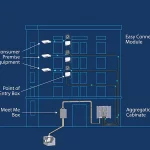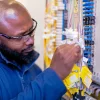Gov to Review UK Rural Broadband Options and 10Mbps USO

The UK Government has today launched two interesting new consultations, including one that is seeking views on a looming review of the legally-binding 10Mbps+ Universal Service Obligation (USO) for broadband and another that will help better understand how to improve broadband for “Very Hard to Reach” areas.
We’ll start with the somewhat maligned USO. The obligation, which was introduced in March 2020, is aimed at those who can’t yet receive a 10Mbps or faster download and aren’t expected to be covered by such a network in the next 12-months. Supplied by UK ISPs KCOM (Hull) and BT (rest of the UK), the USO made it possible for such isolated users to request a service capable of 10Mbps+ downloads (1Mbps upload) etc.
At the last update in April 2023, BT revealed that it had provided a USO connection to over 7,000 premises (up from 5,900 in Oct 2022), with 800 further builds in progress (down from 2,000). Many of those who pursued the USO say they were offered 4G (mobile broadband) connections, but those considered delivered under the USO itself usually get full fibre (FTTP) lines. Commercial builds of the latter have also helped to shrink the USO gap.
Advertisement
Ofcom currently states that 62,000 UK premises currently fall into this gap (i.e. those outside of suitable fixed line, fixed wireless and 4G mobile coverage), which rises to 428,000 premises if you exclude wireless solutions (here). Sadly, some homes are would simply be too expensive for the even the USO to tackle (examples), at least in its current form (we’ve seen some tiny and sparse communities being quoted £1-2m).
Suffice to say that 4G is a highly variable method of broadband connectivity, particularly in rural areas, and fixed-line based alternatives are rarely viable enough (cost) to be delivered into remote rural areas under the USO. In short, the whole approach hasn’t been as effective as the aspirations that resulted in its creation, while the wider market and build plans have changed a lot over the past 3 years.
However, when the related legislation was finalised, it did include a trigger to start a formal review of the policy – once 75% of UK premises take up a 30Mbps (“superfast“) service. As of September 2022, 70% of premises have taken such a service, which does not take into account wireless networks whose available service has continued to increase in recent years. “It is likely that a formal review of the broadband USO will therefore be triggered shortly,” said the government today.
Consultation Focus
Based on previous discussions with stakeholders and correspondence the department has received from both applicants and parliamentarians affected by the broadband USO, we have identified the following areas we believe require review:
• Awareness of the broadband USO and the ability to apply for it
• Industry’s delivery of the programme
• Costs associated with the programme, including the reasonable cost threshold
• The broadband USO’s funding mechanisms
• In addition to the above, we are also taking this opportunity to consult on the following areas:
• The policy objectives of the broadband USO
• The service requirements and eligibility of applicantsThe consultation will look at each of these areas in turn, and the issues presented, but does not set out any individual mechanisms in detail. Instead, it sets out a range of potential means to address them and welcomes stakeholders’ views on their viability.
The most cost-effective approach here may be to update the USO so that it can take account of recent developments, such as the launch of faster Low Earth Orbit (LEO) based broadband satellite services from Starlink and OneWeb. A number of related trials, some involving BT, are currently taking place across the UK to assess both as additional solutions for rural areas (examples here and here).
Advertisement
However, any bigger changes, such as significantly raising the required speeds, would risk requiring a huge injection of funding, triggering competition concerns by rivals and almost certainly end up being rejected by the industry. Most network operators, except for BT and KCOM, balked at the wider legal and cost obligations of taking on the 10Mbps USO.
Secretary of State for Rural Affairs, Thérèse Coffey, said:
“Our countryside, home to millions of people, is rich in potential and we want to make sure that everyone can develop their skills and reach the opportunities for success.
So whether through improved connectivity, housing or transport I’m championing rural communities as we seek to grow our economy – so that every part of our country gets the support it needs to thrive.”
The government’s new consultation on all this is expected to run until 11:55pm on 27th November 2023 (here), but it’s not the only rural broadband consultation being launched today. On top of this, they’ve also begun YET ANOTHER consultation (here) that “will help us to better understand how to improve broadband for Very Hard to Reach” areas.
Very Hard to Reach Areas
At present, the Government’s £5bn Project Gigabit broadband scheme aims to extend 1Gbps capable (download speed) networks to reach nationwide coverage (c. 99%) by around 2030 (here). But the government has also previously recognised that 0.3% of UK premises (i.e. under 100,000) will be “Very Hard to Reach” (i.e. too expensive for even Project Gigabit to tackle). This is roughly the same area as the USO, hence why we’re seeing both consultations being published at the same time – alignment.
The Government has already consulted upon alternative options for tackling VHTR areas (here), such as by considering LEO based satellite and fixed wireless access solutions. As above, we’ve already seen some related LEO satellite trials, and thus we’re unsure what the government expect to learn from this latest review that isn’t already abundantly obvious from past reviews.
Advertisement
VHTR Consultation Focus
The purpose of this consultation, which will be open for 8 weeks, is to set out further detail on our policy positions, provide further details on the analysis carried out as a result of the call for evidence responses and give respondents the opportunity to provide further evidence on any progress they have made or further barriers they have encountered since the call for evidence closed. This consultation specifically covers the following areas:
• The government’s policy position
• Our evaluation criteria for determining policy options and the potential options available to us
• The service parameters that very hard to reach premises may require
• Barriers to delivery that remain for very hard to reach premises.The consultation will look at each of these areas in turn, setting out our proposals where applicable but also providing a range of potential options the government is considering. We welcome stakeholders’ views on any, and all, issues addressed as part of this document.
The new consultation will remain open for feedback for the same length of time as the USO one above. But the realities here are that, unless the government provides much more funding to tackle those extremely remote areas with full fibre delivery (they’ve already largely dismissed that idea under Project Gigabit), then they’re likely to be left with a policy that favours a mix of satellite, fixed wireless and mobile network based solutions. Much like has always been the case.
Mark is a professional technology writer, IT consultant and computer engineer from Dorset (England), he also founded ISPreview in 1999 and enjoys analysing the latest telecoms and broadband developments. Find me on X (Twitter), Mastodon, Facebook, BlueSky, Threads.net and Linkedin.
« FullFibre Ltd and Digital Infrastructure to Merge UK FTTP Networks





















































How do these super hard to reach areas get drinking water, sewage disposal, and electricity? Can they not just stick the FTTP cable down one of those ducting pipes?
Remote areas often do not have mains water or sewage – the may have local water sources and septic tanks for sewage. Gas mains are also unlikely in the most remote areas, more likely to have oil storage delivered by lorry. Electricity and copper phone lines did reach them, but just like broadband it came later that the rest of the country and at a higher cost thanks to long overhead cabling, with a higher chance of failure.
Indeed. I was running a youth group residential in a rural location… and the pump for the on-site spring failed, so we had no water! Was a very tense few hours while engineers were called and got the pump fixed!
Easy why don’t they use water sewage to put FTTP there? Government are useless brain.
Sometimes you can, but a lot of sewage and older water pipes end up being too difficult or unstable to use (use of the water mains is still going through trials). It costs money to survey and identify those, so for small/sparse communities the cost is still an issue. Some of these homes may also not be connected to sewage etc.
And if you have valves that need to close, it’s tricky to get the fibre past them.
Hard to reach areas don’t have sewers.
I firmly believe 35meg should be the min anyone can get. Gives you 25 for the 4k streams and 10 meg for other use.
I agree, anything less is pointless in 2023. The same minimum should be set for 4g also.
@Buggerlugz, sorry you cannot set any minimum speeds for mobile broadband, it won’t work. Because to get those speeds masts need to be erected and there are endless people more then happy to protest against them and block any planning applications. I was reading about some locals who are even protesting and trying to block telegraph poles in their village, they are being erected to bring FTTP to the homes!
For mobile broadband speeds to have minimum speeds, planning laws need to be changed.
You don’t need more masts, you need spectrum, backhaul and putting a stop to oversubscription. That is the only thing stopping them providing a decent reliable service 24/7 most of the time.
The USO is not just a rural issue. Some of my neighbours are on BT’s 4G USO solution simply because the FTTC cabinet ran out of capacity early in 2020 and has been at capacity ever since (barring the odd days when a port becomes available for reuse due to someone moving out).
Hopefully any update to the USO will address the issue of properties that are marked as superfast enabled in BDUK databases but stuck with ‘waiting list’ and slow ADSL in practice.
Agreed, that’s one of those irritating cases that doesn’t always get picked up properly.
If premises have landlines, maybe the government should change legislation to mandate existing copper lines can be replaced route for route with fibre without a legal requirement to get new wayleaves?
Would that simply the process and reduce costs?
the USO turned out to not be fit for purpose for us, we fall into one of the categories Mark called out with a high price to get a solution via the USO. just because you have the right to ask for it, doesn’t mean you’ll get a reasonable response.
Working with the local council we spoke with various providers to see about a private project. we had Airband say “maybe”, but only if we could get an entire town to adopt their services as well. That town had no interest since they already have a reasonable network. Local gov suggested that Airband should cover us as “they are under contract to provide a service”, which turns out to be not accurate.
4G in our area doesn’t meet the USO standards, average 6Mb with an external antenna to boost the quality, and even then it was very unreliable. it would often only work 5 out of 7 days due to a reoccuring fault. I think the network just gets rebooted when it fails rather than replace some failing kit (I am assuming).
Openreach still have nothing on their roadmap for us, so any hopes of being included in the 2025 target seem gone. Zero altnet providers in the area. We do have a local primary school in a nearby village so I am hopeful under the government pledge that all schools to get “high speed internet” by 2025, something may happen in the area (I doubt it will).
we fall into the category of having water and power lines to the property, but nothing else. on site fuel and waste tanks etc.
Luckily, STARLINK has been amazing. we pulled the trigger on it about a year ago and it’s been rock solid for us. in the past few weeks I’ve now had the land line disconnected and all services on it terminated. fedup of classic ADSL, 1.5down and .15 up when it worked with high latency all the time. If it wasn’t for Starlink we would still be trying to use the flaky 4G connection with landline as a backup to work from home.
The government could massively simplify this by negotiating a geo-ringfenced service from Starlink (so only available in USO difficult areas) and then making that available without VAT I.e. more affordable.
Absolutely a good approach. Provided the UK service provider çontracts with a satcoms provider subject to meaningful and enforceable governance. Good luck with that.
One of the issues with Starlink is the price, so any deal would need to support a cheaper / more affordable tariff than currently exists – possibly alongside a slower service speed (current USO eligible packages must not cost more than £45 per month, or something like that).
But there are other approaches too, such as using the LEO satellite networks for backhaul to a fixed wireless or even local fixed line network, where fibre lines are not an option.
Our hamlet in Herefordshire is a few hundred meters from the nearest Openreach fibre trunk. Poles for telephone are already in place; a one day job according to an OR engineer…
No plans from them or any of the alt-nets to get us connected any time soon. The priority is clearly large towns and cities to keep the numbers up.
Its more random than that. Take my area (south west Hampshire) – Southampton has almost zero openreach fiber. Yet little hamlets in the new forest have it (Exbury – USO?). Some towns have multiple options (totton, marchwood), some villages do too (Fawley) and some towns have nothing from openreach (Hythe, Ringwood) but do have some altnets with very limited coverage. It a pure postcode lottery. I think openreach are following a strategy of covering places with large USO issues, then easy installs and finally where there is competition. Even guessing that its still a little random… (For example why does Marchwood a tiny town have 2 altnets and openreach fibre I’ll never know when there are larger nearby towns with nothing???)
There are a lot of premises with fibre running literally right past them with no access to it. It doesn’t actually mean much having ‘trunk’ fibre running nearby, that fibre is for other things than to serve homes and businesses directly, doesn’t have the equipment either end necessary and can’t just be broken into to serve those premises.
Need new cabling from some endpoint right through to the home. Those trunks/spines are spoken for.
Problem with any of these targets is they will always leave someone out who’s on the edge. I know I’m considered superfast as I’m over the 30Mb target but only just (and I can sometime be below if I’m unlucky with the FTTC retraining). It means you disappear off the radar (Hampshire superfast considered me superfast covered). I suspect the same happens with a lot of near USO users. Maybe bumping the target a couple of Mb every few years is a better way of mopping up the edge cases while not dumping lots of USO costs at once?
All the suggestions of wireless options, including Starlink, are only considering speed. For a lot of uses – telephony and video calls, online games, remote work for example – reliability is just as important as speed. For true reliability the only option is fibre.
Can honestly say, Starlink has been way better than I expected. I’ve noted I get about a 60 second drop out around 4AM, I think where it may be changing the sat it’s talking to. Other than that, it’s been rock solid, low latency. The only other time I’ve seen it drop out was in the middle of an EPIC lightnintg storm for around 5 mins.
I just went through the pain of enabling my network via PfSense for IPv6 based on how the starlink kit works as well, which turned out to be much easier than expected. I use it for multiple VOIP systems, gaming, as well as general use etc.